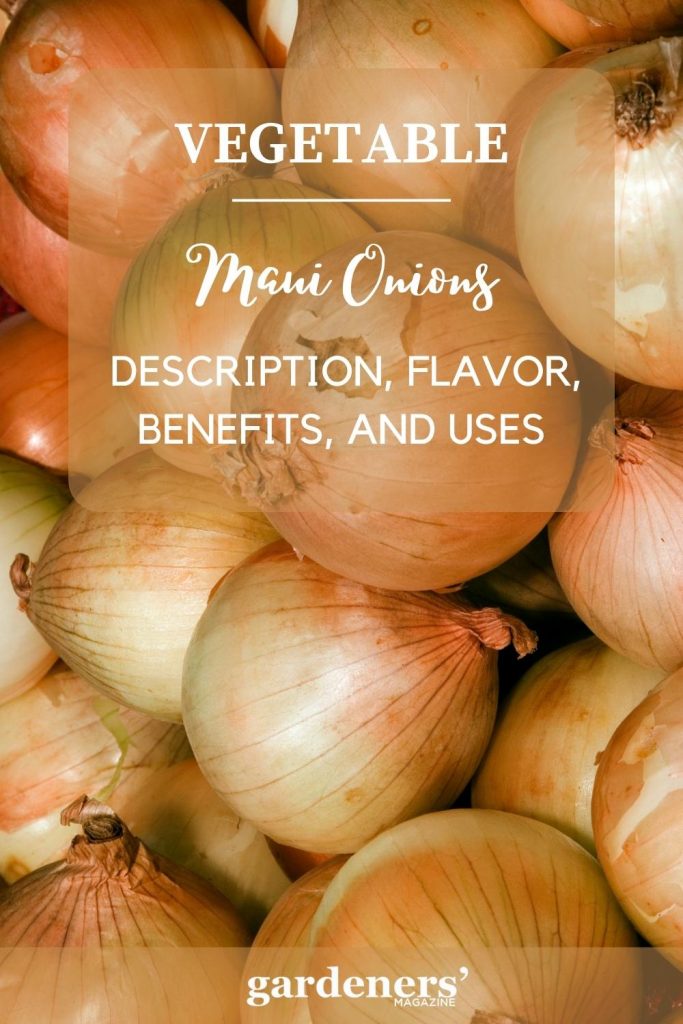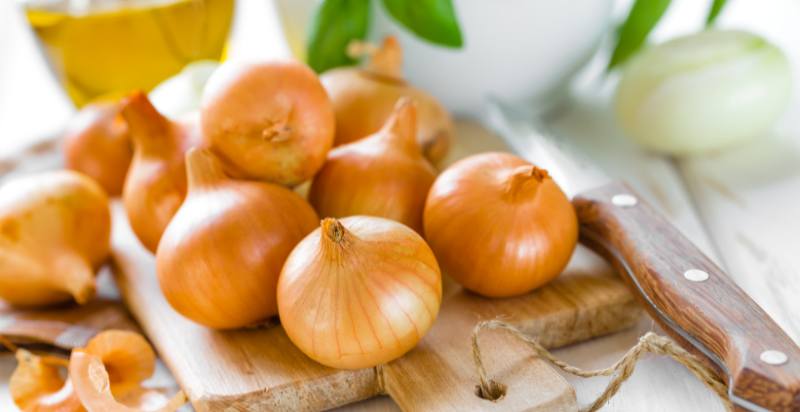Maui onions are sweet onions grown in the Hawaiian Islands, known for their mild flavor and unique shape. Maui onions are typically larger than traditional onions and have a mild, sweet flavor that makes them perfect for salads, sandwiches, or as a side dish. They’re also popularly used in Hawaiian cuisine, lending a unique flavor to many dishes. In this article, we’ll explore the history of Maui onions, their nutritional benefits, and how to cook with them.
What are Maui Onions?
Maui onions are a type of sweet onion grown in the Hawaiian Islands and are known for their mild flavor and unique shape. They’re a part of the Allium genus, which includes other popular onions such as shallots, leeks, and scallions. Maui onions are typically larger than traditional onions, with white to light yellow flesh. They have a mild, sweet flavor that makes them perfect for salads, sandwiches, or as a side dish.

History and Origin of Maui Onions
Maui onions have been grown in Hawaii for more than 500 years. It is believed that they were introduced to the islands by Polynesian settlers who brought them from their native Tahiti and Samoa. The onion quickly spread through the Hawaiian islands, becoming a staple crop used widely in traditional recipes and cooking techniques. Maui onions are also known as sweet onions due to their typically mild flavor and very sweet taste.
The traditional Maui onion is mostly white with a yellowish or red tinge on the outside, while some modern varieties have been developed that are more reddish. In addition to their flavor, Maui onions also boast a higher sugar content than regular onions, making them an ideal choice for salads and other dishes . Today, Maui onions can be found in many grocery stores across the United States and grown on farms around the Hawaiian Islands. The onions are also exported to countries such as Japan and Canada, where they continue to be a popular ingredient in recipes.
Description of Maui Onions
Maui onions are a type of onion that typically grows in Hawaii. They have an elongated shape and are 4-6 cm in diameter. Their skin is thin and papery, ranging from white to purple, depending on the variety. Maui onions have a mild sweetness that is enhanced when caramelized. They are often used in Hawaiian cuisine, particularly for poke bowls and other seafood dishes. The onions can also be pickled or used as a topping for burgers and hot dogs.
Health Benefits of the Maui Onions
Maui onions are a powerhouse of nutrition. They are an excellent fiber, folate, vitamin C, and potassium source. The sulfur-containing compounds in onions also provide antioxidant benefits, which can help to reduce inflammation and promote a healthy immune system. Maui onions are linked to lower cholesterol levels, better blood sugar regulation, and improved digestion. In addition to these benefits, Maui onions contain flavonoids and phytonutrients, which can help reduce the risk of certain diseases.
Flavor Profile of the Maui Onions
The flavor of Maui onions is surprisingly sweet and mild, making them a great addition to many dishes. When cooked, the onions become even sweeter with a slight hint of licorice or anise-like taste. They are also often described as having a buttery texture and soft crunch. Considered one of the world’s finest sweet onions, Maui onions are often used raw in salads and sandwiches but can also be roasted, grilled, caramelized, or pickled.
Maui onions pair with lighter flavors like citrus, herbs, and vinaigrettes. They also make a wonderful addition to seafood dishes such as ceviche or fish tacos. Whether you’re using them in a salad, soup, or main dish, Maui onions will bring out the best flavor of any dish. So, grab yourself a bag of Maui onions and get cooking! You won’t regret it.
Seasonality and Availability throughout the year of Maui Onions
Maui onions are available during the winter and spring months, from November through April. In addition to being native to Hawaii, these onions can also be found in select supermarkets across the United States. The peak season for Maui onions typically runs from January through March. During this time, the onions are especially sweet and flavorful.
Cultivation of the Maui 0nions
Maui onions are grown from seed. Seeds are generally planted in mid-to-late November or early December in Hawaii. The onions take approximately 110 to 120 days to reach maturity. Soil preparation is an important step in the cultivation of Maui onions. The soil should be light and well-drained, with a pH of 6.0 and 7.5.
Adequate amounts of organic material should be added to the soil before planting; this helps provide nutrients for the onion plants as they grow. Fertilize the soil with a 10-10-10 fertilizer before planting. The onions are planted in rows approximately 6 to 10 inches apart. After sowing the seeds, cover them lightly with soil and water the area thoroughly. Weeds can be problematic for Maui onion growers; they should be hand weeded or mulched to reduce weed pressure.
Harvesting of the Maui Onions
The harvesting of Maui onions begins in late April and runs through mid-July. The first step is to prepare the field for harvest by tilling, weeding, and fertilizing. This ensures that the onions will grow large and flavorful. Once the soil is ready, it’s time to begin planting. The onion sets are placed 2 inches deep into the soil, spaced 4-6 inches apart. The onions will then grow and mature over several weeks.
When the plants are ready to be harvested, they must be carefully hand-picked; otherwise, they may break or become damaged during harvesting. Each onion is pulled from its root gently so as not to damage it. Once picked, the onions are washed with a hose and dried in the sun.

What are the things to remember when buying Maui Onions?
- Look for onions that are firm and free of blemishes. Soft spots or mold indicate that the onion is beginning to spoil, so it’s important to look closely at each before purchasing.
- Select Maui onions with vibrant yellow-golden skin; this indicates a sweeter flavor when cooked. Avoid bulbs with green streaks, as these tend to be more pungent.
- When shopping for Maui onions, it is best to buy them in smaller quantities so they do not spoil before use.
- Finally, remember that Maui onions are generally more expensive than others, so it’s important to consider the cost when purchasing. However, the unique flavor of Maui onions makes them well worth it.
What is the Best Way to Store Maui Onions?
The best way to store Maui onions is in a cool, dry area with good air circulation. If you do not have space to store them upright, you can lay them flat in an open container or basket. Keep them away from potatoes and other fruits and vegetables, as they can absorb odors and flavors from these items. Make sure the container or basket is clean and dry, as any moisture can lead to spoilage. You should also check your onions frequently for signs of mold or rot. If any appear, discard the affected onion immediately. Stored properly, Maui onions can last several weeks in a cool, dry area.
If you need to store them for longer, it is best to wrap them individually in paper towels and place them in a container or sealable plastic bag. Remove as much air from the bag as possible before sealing it shut. Place the sealed bag in the refrigerator, but be aware that this will cause the onions to lose some flavor over time. This method should keep your Maui onions fresh for several months.
No matter how you store your Maui onions, always inspect them before using them in cooking or eating them raw. Discard any that are soft, slimy, or showing signs of rot. You can enjoy these sweet and juicy onions with the right storage techniques for weeks.
How can Maui Onions be Used in Recipes with Other Fruits and Vegetables?
Maui onions pair well with a variety of other fruits and vegetables. They can be used in salads, sandwiches, soups, curries, stir-fries, omelets, quiches, and more! For example, add them to an Asian-inspired stir-fry dish with broccoli and pineapple chunks or make a warm potato salad with Maui onions, peas, and carrots.
You can also use them to top off any burger or sandwich for a zesty kick of flavor. If you want something more sweet, try caramelizing the Maui onions in a pan with butter and honey and then adding it to your favorite fruit pies or cobblers. No matter how you use them, their mild flavor will add a unique sweetness to any dish.
Conclusion
Maui onions are a sweet and juicy variety that can add flavor and zest to various dishes. When stored properly, these onions can last for several weeks before needing to be replaced. Inspecting them for signs of rot or spoilage before using them in recipes is important. Maui onions pair well with other fruits and vegetables and can top off burgers, sandwiches, stir-fries, salads, and more. With their mild sweetness and unique flavor, Maui onions are a great addition to any kitchen.
- Everything You Wanted to Know About Red Tamarillos - June 2, 2025
- A Guide to Tulips: Everything You Need to Know & More… - June 2, 2025
- Guanabana: Description, Flavor, Benefits, And Uses - May 27, 2025

5 thoughts on “Maui Onions: Description, Flavor, Benefits, And Uses”
Comments are closed.